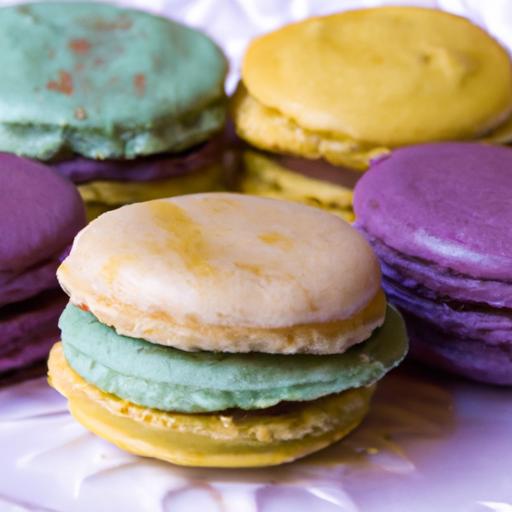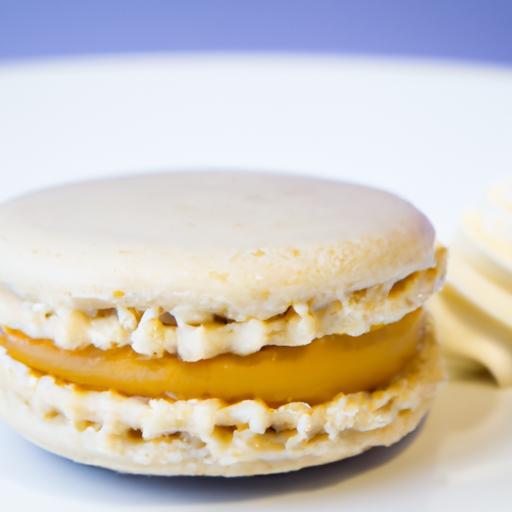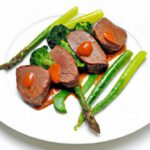Beneath the delicate, pastel-hued surface of a macaron lies a world where art meets science in a sublime dance of flavors and textures. While these petite confections are often celebrated for their sweet allure, a savory macaron introduces an unexpected twist-a symphony of tastes that tantalizes the palate with every bite. But what exactly happens at the molecular level to transform simple ingredients into this crispy, airy, and richly flavored masterpiece? In this article, we unravel the chemistry behind the perfect savory macaron delight, revealing how precise reactions, balanced pH, and ingredient interplay craft a culinary experience that is as fascinating as it is delicious. Join us as we explore the science that elevates this French classic beyond its sugary stereotype and into the realm of savory perfection.
The Chemistry Behind the Perfect Savory Macaron Delight invites both seasoned chefs and adventurous home bakers to explore the fascinating interplay of science and flavor that transforms humble ingredients into a sublime culinary experience. Savory macarons, with their crisp shells and luscious, aromatic fillings, tap into the essential principles of emulsification, chemical reactions, and ingredient balance – crafting a bite where every texture and note harmonizes gracefully.
Prep and Cook Time
Preparation: 45 minutes | Resting: 30 minutes | Baking: 15 minutes | Total: 1 hour 30 minutes
Yield
Approximately 24 savory macarons (12 filled sandwiches)
Difficulty Level
Advanced – requires attention to detail and precise technique
Ingredients
- 100g almond flour, finely ground and sifted
- 100g powdered sugar, sifted
- 75g egg whites, aged at room temperature (about 3 days)
- 25g granulated sugar
- 10g black sesame seeds, toasted and finely ground (optional, for deeper flavor)
- 1/4 tsp cream of tartar
- ½ tsp coarse sea salt
- Fresh herb filling: 100g cream cheese, softened
- 1 tbsp finely chopped chives
- 1 tbsp finely minced roasted garlic
- 1 tbsp unsalted butter, softened
- Salt and freshly ground black pepper to taste
- Optional garnish: Microgreens or edible flowers
Instructions
- Prepare the dry mixture: In a large bowl, gently fold together the sifted almond flour and powdered sugar with the toasted, ground black sesame seeds and the sea salt. Set aside.
- Whip the egg whites: Using a stand mixer, start beating the egg whites on medium speed. When they become frothy, add the cream of tartar to stabilize. Gradually add the granulated sugar, increasing speed to high until glossy, stiff peaks form-this signifies stable meringue, crucial for smooth shells.
- Macaronage: Gently fold the dry ingredients into the meringue in three increments. Use a spatula, folding and pressing to deflate just enough to achieve a batter that flows like ‘lava’-smooth and slightly runny but not liquid. Overmixing or undermixing affects shell formation.
- Piping the shells: Transfer batter to a piping bag fitted with a round tip. Pipe 3.5 cm rounds onto parchment-lined trays, spaced well apart. Firmly tap trays against the counter to release trapped air bubbles, preventing cracked tops.
- Resting the shells: Allow the piped shells to rest at room temperature for 30 minutes until the surface forms a delicate skin-this step is critical for that iconic macaron “foot” and smooth, crisp shell.
- Baking: Preheat the oven to 150°C (302°F). Bake one tray at a time for 14-16 minutes. Macarons are done when they have risen feet and the tops are set but not browned.
- Cooling: Let the shells cool completely on the baking sheet before gently peeling off.
- Prepare the filling: In a bowl, combine cream cheese, butter, chopped chives, and roasted garlic. Season with salt and pepper. Whip until smooth and spreadable.
- Assembling: Pair macarons by similar sizes. Using a piping bag or spoon, spread or pipe a generous dollop of herb filling onto one shell, then sandwich with its partner.
- Rest and serve: Refrigerate assembled macarons for at least 24 hours to meld flavors and achieve perfect texture before serving. Bring to room temperature before enjoying.
Tips for Success
- Egg whites: Aging egg whites reduces moisture, improving stability and shell texture. Avoid using freshly separated whites.
- Emulsification: Achieving a proper macaronage is a form of emulsification – blending fat-based almond flour with the aqueous egg whites to form a harmonious batter. Use gentle folding motions to avoid deflating too much.
- Oven calibration: Baking temperature is key. Use an oven thermometer to ensure your oven heats evenly at the precise temperature to develop perfect feet.
- Ingredient selection: For savory macarons, select fillings with natural emulsifiers like cream cheese or butter to marry flavors and textures. Experiment with finely chopped herb blends, mild cheeses, or even smoked salts.
- Make ahead: Macaron shells can be frozen for up to a month; thaw before filling. Filled macarons maintain freshness refrigerated for up to 3 days.
Serving Suggestions
Serve these delicate savory macarons as an elegant appetizer or party treat. For added visual allure, garnish with microgreens or sprinklings of edible flowers atop the filling once assembled. Pair with a crisp, light white wine or a refreshing herbal iced tea to complement the subtle herbal layers. Present on a minimalist platter where their delicate textures and intricate shapes can truly shine, inviting guests into the chemistry and art behind each bite.
| Nutrition (per macaron) | Calories | Protein | Carbs | Fat |
|---|---|---|---|---|
| Calories | 85 kcal | 2 g | 7 g | 5 g |
Discover more herb and spice combinations to elevate your macaron repertoire. For a deeper dive on the science of emulsification in baking, visit ScienceDaily’s food chemistry section.

Q&A
Q&A: The Chemistry Behind the Perfect Savory Macaron Delight
Q1: What makes a savory macaron different from a traditional sweet macaron?
A1: At its core, a macaron is a delicate meringue-based cookie paired with a flavorful filling. Unlike traditional sweet macarons that rely on sugar and sweet fillings, savory macarons balance the chemistry of the meringue with umami-rich or tangy ingredients like cheese, herbs, or smoked meats. The challenge is maintaining the classic macaron texture-crisp shell and chewy interior-while introducing savory elements without compromising structure or flavor harmony.
Q2: How does the chemistry of egg whites contribute to perfect macarons?
A2: Egg whites are the magical backbone of macaron batter. Their proteins, when whipped, create a stable foam by trapping air and forming a network that holds the structure. This aeration is crucial for the macaron’s signature rise and texture. For savory versions, the meringue often has to balance salt and other additives that can denature proteins or affect whipping, so precision in pH and ingredient ratios is key to preserving foam stability.
Q3: What role does almond flour play in macaron chemistry?
A3: Almond flour provides the macaron with its characteristic nuttiness and fine texture. Chemically, it adds fats and proteins that interact with the meringue’s protein matrix. The almond’s oil content can affect batter viscosity and moisture retention, contributing to the shell’s delicate crispness and chewy interior. For savory macarons, the almond’s subtle flavor acts as a perfect canvas for bolder taste profiles.
Q4: How do savory fillings impact the overall chemistry of the macaron?
A4: Savory fillings introduce moisture, fats, and acidity that can affect shell integrity and shelf life. Acidic components (like vinaigrettes or citrus) might soften the shells faster, while creamy cheeses add richness but can weigh down the delicate cookies if too wet. Balancing filling consistency-often by controlling moisture and using stabilizers like butter or cream cheese-is essential to maintain textural harmony and ensure the macaron doesn’t become soggy.
Q5: What baking techniques ensure the perfect texture for savory macarons?
A5: Timing and temperature control are critical. Savory macaron shells are baked low and slow to let the meringue proteins set without browning excessively, preserving their pale color and tender shell. Proper resting (“drying” the shells before baking) allows a “skin” to form, which prevents cracking and helps develop the iconic “feet.” Additionally, precise folding of batter ensures the right balance between aeration and density, crucial for supporting savory fillings.
Q6: Can the chemistry of macarons be altered for dietary preferences like gluten-free or vegan diets?
A6: Absolutely. Almond flour is naturally gluten-free, making macarons inherently safe for gluten-free diets. For vegan macarons, aquafaba (the liquid from chickpeas) can replace egg whites. However, aquafaba behaves slightly differently, requiring adjustments to whipping times and stabilizers. The chemistry shifts subtly but with patience and experimentation, one can achieve a savory vegan macaron with comparable texture and taste.
Q7: Why is understanding the chemistry important for creating innovative savory macaron flavors?
A7: Knowing the underlying chemistry empowers bakers to experiment confidently with unexpected flavor combinations-like smoked salmon and dill, roasted garlic and thyme, or truffle and parmesan-while maintaining structural integrity. It is the science that transforms whimsical culinary ideas into delicious, reliable creations, ensuring every bite delivers a perfect balance of texture, flavor, and savory delight.
Future Outlook
As the dance of molecules settles and the final bite lingers on your palate, the chemistry behind the perfect savory macaron reveals itself not just as a scientific marvel, but as an artful alchemy. From the delicate balance of protein structures to the precise pH that molds its texture, every savory macaron is a testament to the harmonious interplay of ingredients and technique. In understanding these chemical symphonies, we don’t just appreciate a pastry-we unlock the secrets to crafting edible experiences that surprise and satisfy in every bite. So next time you savor that crisp shell and luscious filling, remember: behind this delightful treat lies a world where science and flavor blend flawlessly, proving that even the smallest bite can encompass a universe of culinary chemistry.


